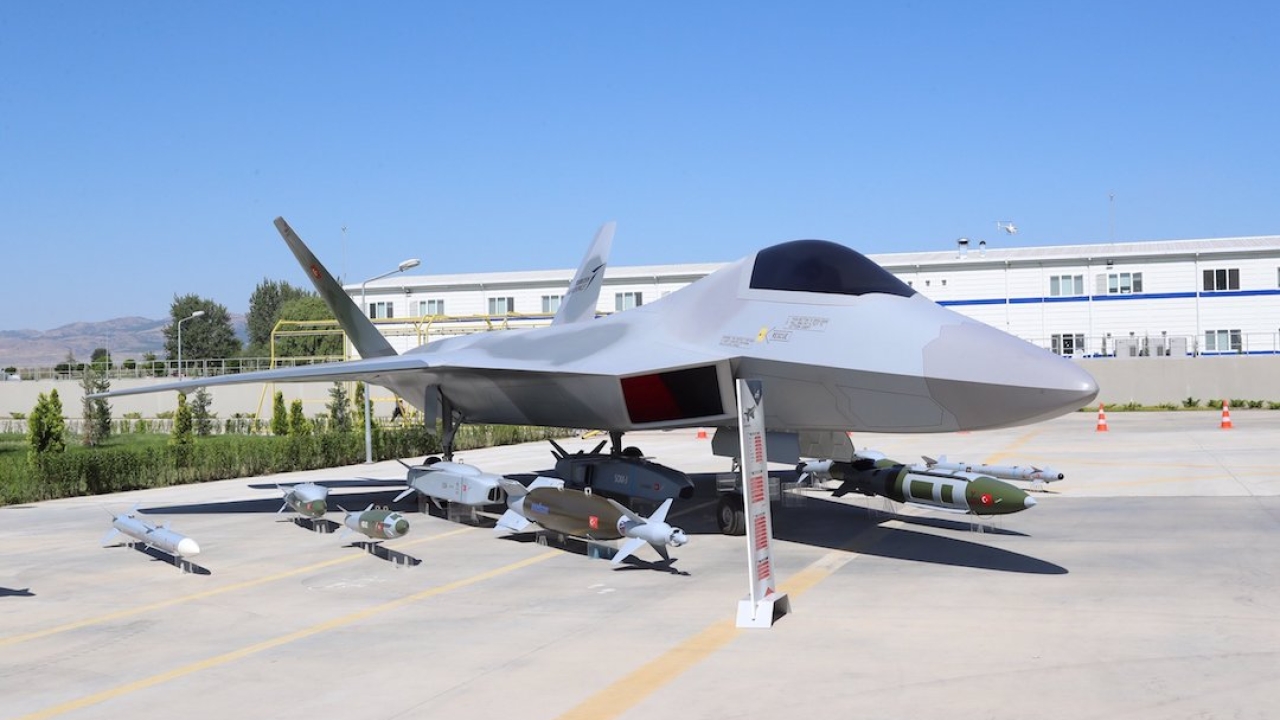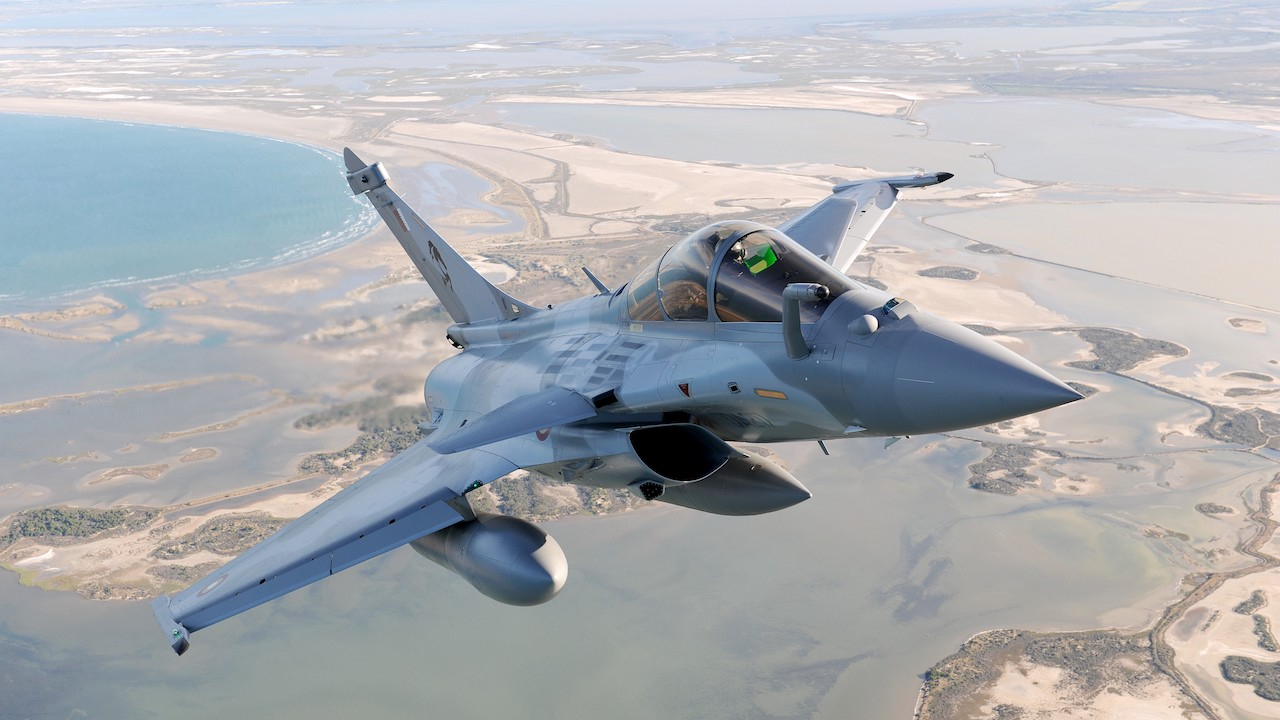Thoroughly modern milli...
Turkish Aerospace Industries formally exhibited the country’s new National Combat Aircraft or Milli Muharip Uçak (MMU) at the 15th International Defence Industry Fair (IDEF) in Istanbul.

The mock-up of Turkey’s new MMU fighter, surrounded by some of the weapons it will carry in service. Picture: TAI.
The MMU was previously known as the TF-X and is an indigenous fifth-generation fighter developed by prime contractor TUSAŞ/Turkish Aerospace with technological assistance from BAE Systems.
Some 250 of these stealthy tactical fighter aircraft are due to be procured between 2029-2040, and the programme is now designated as a ‘national survival project’.
The Turkish Ministry of Defence is having to chart a new course following the country’s unceremonious ejection from the US-led F-35 Joint Strike Fighter programme. This was a result of the sanctions imposed by the US after Ankara took delivery of the Russian S-400 air defence missile system.
The Turkish Air Force had planned to base its future force structure around a high:low mix of types. Some 25% of the fast-jet force were to be high-end, low-observable (or stealthy) fighters, with the remainder consisting of 4.5-generation aircraft.
Though it has some of the hallmarks of a fifth-generation fighter, Turkey’s new MMU was actually originally intended to be the cheaper, less capable element in this planned high:low mix, replacing the air force’s F-16 fighter jets.
About 100 F-35s were to have provided the ‘high-end’ element. With the termination of Turkey’s involvement in the F-35 programme, this plan is now in doubt.
Instead, in the short term, the service life of Turkish F-16s is likely to be extended, leaving the MMU as the high-end element.
Extending the life of the F-16 to operate alongside the MMU in this way could meet Turkish air defence requirements in the short-to-medium term. A second iteration of the MMU might now eventually fill the high-end platform requirement.
Turkish Aerospace president and CEO, Professor Temel Kotil, said that the company plans to roll out the first MMU prototype (which is due to fly in 2026) on March 18 2023.
This is a significant date for Turks, as 2023 marks the centenary of independence and of the foundation of the Republic of Turkey as a modern and secular nation state. Also, March 18 is the anniversary of what many know as the Gallipoli campaign, but which Turkey remembers as the famous naval victory of Çanakkale, the prelude to the Turkish war of independence.
Kotil was keen to emphasise the involvement of Turkish companies in the design and development of the MMU, ensuring the operational sovereignty of the aircraft. He said: “We have Aselsan for avionics and computer hardware, Havelsan for software, and TAI also has its software team.” He added that even the air conditioning requirements would be met by a domestic supplier.
The MMU programme will be divided into three phases.
Phase one, stage one will include the preliminary design review, while stage two will include more detailed design and qualification.
Phase two will begin in late 2028 and will include the delivery of 10 ‘block one’ aircraft.
Phase Three will begin in 2034, with follow-on blocks being delivered that year and into the future.
A system requirements review (SRR) later this year will see the air force’s operational requirements transformed into objective, measurable plans. A system functional review (SFR) will also take place by the end of the year, breaking down the requirements at a system level, while also setting the key user requirements (KURs).
Late 2022 will see the preliminary design review and the finalising of the aircraft’s shape, sensors and sub-systems.
A prototype will be rolled out in early 2023 with a critical design review to follow in mid 2024.
There will be three ‘block 0’ development aircraft and a first flight is predicted for late 2026.
The MMU will be built on big data, artificial intelligence (AI) and sensor fusion, and is likely to incorporate laser-directed energy and electromagnetic pulse weapons.
Its beyond-visual-range (BVR) air-to-air missiles will include Meteor, AMRAAM, MICA and the indigenous Gökdoğan missile, while short-range weapons will include AIM-9X, ASRAAM, and the Turkish Bozdoğan missile.
The fighter will have a reconnaissance pod and a range of air-to-ground weapon options, including the indigenous SOM cruise missile. It only has a 1,000lb internal weapon load but, when not in low-observable configuration, will have six available hardpoints to be able to carry much more.
Turkish Aerospace is also planning to conduct the first flights of both the Hürjet 2 advanced jet trainer and the TAI T929 ATAK combat helicopter on March 18 2023.
The Hürjet is a single-engined, two-seat, supersonic armed trainer aircraft developed by Turkish Aerospace Industries (TAI) and intended to replace the Turkish Air Force’s ageing fleet of Northrop T-38 trainers.
TAI funded the initial development phase of the Hürjet as a private venture, displaying a mock-up at the Farnborough International Airshow in 2017. The following year, the Turkish Air Force signed a deal with TAI confirming the official status of the project and giving it the go-ahead to move forwards.
The aircraft will be used primarily for training Turkish Aeronautical Association (THK) pilots but will also have a secondary close air support capability. The Hürjet flies at a maximum altitude of 13,716 metres (45,000ft), a top speed of Mach 1.4, and with a maximum payload of 3,000kg.
The T929 ATAK 2 is a twin-engined, multi-role, heavy attack helicopter under development by TAI. It will incorporate some subsystems from the T129 currently in service, and also from the T629 unmanned electric attack helicopter currently undergoing testing at the hands of TAI engineers.
The T929 helicopter is designed for close air support, air-to-ground combat, air-to-air combat, armed observation and reconnaissance, and attack missions. It can operate in all-weather environments by day or night, and has a crashworthy and ballistic tolerant design.
Also highlighted at IDEF, the Muharip Insansiz Ucak Sistemi (MİUS) unmanned combat aircraft system (UCAV), which was first unveiled on July 20, is due to fly in 2023.
This low-observable drone will be used as a ‘loyal wingman’ to support the MMU, and as a light-attack aircraft on board the new Turkish amphibious assault landing ship TCG Anadolu.
MIUS will fill the gap left by the cancellation of the Turkish F-35, since the vertical take-off and landing (VTOL) F-35B had been expected to form the backbone of the Anadolu’s air wing.
MIUS will launch from the ship without the help of a catapult, and using conventional arrestor gear on landing. The Anadolu will also embark TB-3 armed unmanned air vehicles (UAVs).
The new UAV will feature an aggressive AI-based autonomous manoeuvring capability to give it a real and robust air-to-air capability, and will initially be powered by a Ukrainian MotorSich AI-25 twin-shaft turbofan engine. This promises to give MIUS a top speed of 0.8 Mach.
Later prototypes will have a new indigenous TF-6000 power plant and will fly at supersonic speed – if Turkish Aerospace Industries can complete the required engine qualification tests in time.
The aircraft will enable satellite communications for control via satellite, though it will also have autonomous capabilities.
Manufacturer, Baykar, says that the MIUS will also perform strategic attack, missile attack, and close air support missions, as well as the suppression of enemy air defences, and is expected to have an endurance of up to five hours.
The aircraft has an internal weapons bay, but on missions where low-observability is not critical, it will carry missiles and other weapons underwing.
This UAV is the result of a decade-long development programme, funded privately by Baykar. According to Selcuk Bayraktar, the company’s chief technology officer, MIUS will enter service in 2023, after a 36-month process from conceptual design to completion.
Stay up to date
Subscribe to the free Times Aerospace newsletter and receive the latest content every week. We'll never share your email address.


